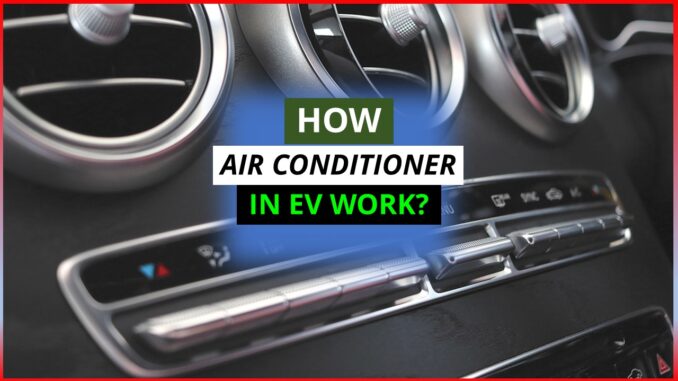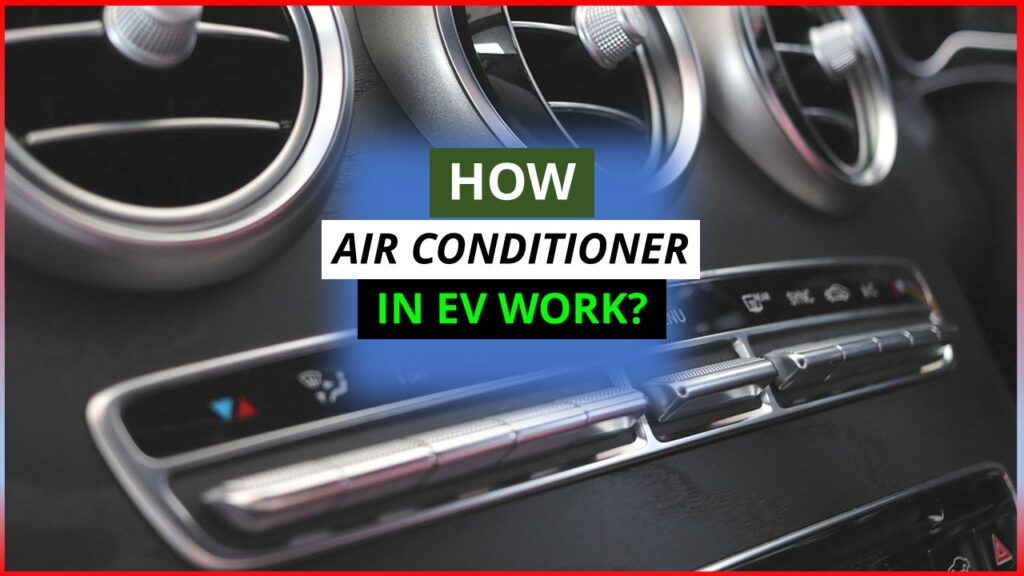
As the world rapidly embraces electric vehicles (EVs) as a sustainable transportation alternative, it’s important to understand the technology behind their various components. One such crucial component is the AC system. In this blog, we will delve into the intricacies of how the AC system in an electric vehicle works, shedding light on its functionality and benefits.
By exploring the key components and operational processes, we aim to provide a comprehensive understanding of how the AC system cools the cabin of an electric vehicle, contributing to a comfortable and environmentally friendly driving experience.
Understanding the Basics: AC System in Vehicles
The AC system in an electric vehicle plays a vital role in providing a comfortable and controlled environment for passengers. Similar to conventional vehicles, EVs rely on air conditioning to regulate the temperature inside the cabin.
However, the AC system in an electric vehicle operates differently, utilizing the vehicle’s electric energy.
The key components of the AC system include the compressor, refrigerant, condenser, evaporator, and expansion valve. The compressor, often referred to as the heart of the system, is responsible for compressing and circulating the refrigerant, which is crucial for cooling the air inside the cabin.
The refrigerant, a specially formulated substance, undergoes phase changes as it circulates, absorbing heat from the cabin and releasing it outside, thus cooling the air.
The condenser facilitates heat transfer by allowing the refrigerant to release heat to the outside environment, enabling the cooling process.
On the other hand, the evaporator, located inside the cabin, helps absorb heat from the cabin air, allowing the refrigerant to evaporate and cool down the air.
The expansion valve regulates the flow of refrigerant, controlling its pressure and ensuring it evaporates in the evaporator coil.
How the AC System Operates
To better understand the operational processes of the AC system in an electric vehicle, let’s explore the typical cooling mode.
1. Cooling Mode
When the driver activates the AC system, the compressor is engaged, and the refrigerant starts circulating. The refrigerant enters the compressor as a low-pressure gas and is compressed into a high-pressure gas.
2. Condensation
The high-pressure gas is then sent to the condenser, where it releases heat and transforms into a high-pressure liquid.
The condenser, typically located in the front of the vehicle, facilitates the dissipation of heat to the surrounding environment.
3. Expansion
The high-pressure liquid refrigerant then passes through the expansion valve. This valve reduces the pressure of the refrigerant, causing it to expand rapidly.
As a result, the refrigerant evaporates and rapidly cools down.
4. Evaporation
As the refrigerant evaporates, it absorbs heat from the cabin air passing through the evaporator. The evaporator, usually positioned behind the dashboard, consists of a coil that allows the refrigerant to evaporate and cool the surrounding air.
The cooled air is then blown into the cabin through vents, providing a comfortable temperature for passengers.
5. Repeating the Cycle
The refrigerant, now in a low-pressure gaseous state, returns to the compressor, and the entire process continues until the desired cabin temperature is achieved.
The cycle repeats as long as the AC system remains active.
Now that we have understood the basics of an automobile AC, let us look at the difference between AC in an EV and a normal car.
How Does The AC In EV Differ
If you think about the power source for an electric vehicle, the answer is quite simple. Everything about electric vehicles, including the compressor, pretty much revolves around the battery.
Electric vehicles (EVs) use a battery-powered electric motor to power their compressors.
The little electric motor activates the compressor in the same way as the power of the engine would typically do in a typical car. Once this procedure is underway, the air conditioning system’s actual operation resembles that of a typical car.
Evaporator and condenser components are also present in the air conditioning systems of electric vehicles, just like in a regular car.
The only drawback to using an electric vehicle’s air conditioning system is that you must be aware that you are consuming battery power, which will reduce the vehicle’s overall range.
Now let us look at what happens when heating the cabin.
How The Heating Happens In An EV
EVs are more effective than conventional internal combustion vehicles when compared to them. In an electric car, the majority of the electrical energy from the battery is turned into mechanical energy when you wish to move, making the process incredibly effective.
However, with an ICE vehicle, a large portion of the fuel’s energy is lost as heat instead of being used to propel the vehicle.
The inefficiency of a petrol engine contributes to keeping your cabin habitable in cold regions without spending much extra energy.
For EVs, additional energy is needed to heat the interior. Driving in icy conditions is not the best option if you’re attempting to extend the range of your EV for this reason.
Some EVs employ resistors that are directly driven by the battery’s electricity to heat the cabin, which is problematic because doing so reduces the EV’s range.
When you’re travelling in extremely cold weather and your range is quickly dwindling but you still need to turn up the heat, this becomes an issue.
It can become a little frightening if the closest charging station is far away. It makes sense why some people experience range anxiety.
Mechanism Of The Heat Pumps
Because it functions like a regular air conditioner, the heat pump is a fantastic choice. Even more recognisable parts of heat pumps are a compressor, an evaporator, and a condenser.
Together, these components help heat electric vehicles in the winter. The heat pump is an incredibly clever gadget that, in essence, flips the result of your conventional air conditioning loop, giving heat instead of cold air.
When it comes to heating, a heat pump is more effective than resistors. The secret is that the heat pump transfers energy to the refrigerant in the evaporator by using outside air rather than solely using power from the battery to heat the cabin.
Due to its extremely low boiling point, this refrigerant starts to boil and then transforms into a gas that moves to the compressor. As the refrigerant moves through the compressor, a hotter, higher-pressure gas is produced.
This heated gas is sent to the condenser, where it is brushed by air to deliver heat to the car’s interior. The refrigerant is cooled throughout this procedure, returning it to a liquid state.
The process is repeated repeatedly and is significantly more effective than heating the car with resistive parts because energy is being introduced from the outside environment.
There will come a time when the heat pump won’t operate as well if the outside air is sufficiently chilly. While this is true in exceptional circumstances, the heat pump will function flawlessly in the majority of winters.
Now that we have discussed the various mechanisms involved in the AC system of an EV, let us look at some of the advantages

Benefits of an AC System in Electric Vehicles
The AC system in electric vehicles offers various benefits, contributing to the overall driving experience and sustainability of EVs.
1. Energy Efficiency
Electric vehicles have an advantage over traditional vehicles as they can utilise the electric powertrain for operating the AC system. Unlike conventional vehicles that rely on engine power for running the AC, electric vehicles can use electricity directly from the battery pack.
This results in improved energy efficiency, as the electric powertrain is highly efficient compared to internal combustion engines.
2. Reduced Emissions
Since the AC system in electric vehicles is powered by electricity, it contributes to reduced emissions. By eliminating the need for engine power to operate the AC, electric vehicles minimise the release of greenhouse gases and pollutants associated with conventional vehicles.
This aligns with the overall environmental benefits of EVs and supports efforts to combat climate change.
3. Preconditioning Capability
Electric vehicles often offer the convenience of pre-conditioning, allowing users to cool or warm the cabin before starting their journey.
By utilising the vehicle’s charging infrastructure, users can remotely activate the AC system using a smartphone app.
This feature ensures a comfortable experience right from the beginning, without relying on the vehicle’s battery while driving.
4. Noise Reduction
Electric vehicles are known for their quiet operation, and the AC system plays a part in maintaining this peaceful environment.
Compared to traditional vehicles with engine-driven AC systems, electric vehicles with their electric powertrain provide a quieter and more serene cabin experience.
5. Thermal Management
The AC system in electric vehicles also contributes to efficient thermal management. As electric vehicles rely on battery packs, which are sensitive to temperature fluctuations, the AC system helps maintain optimal battery operating conditions.
By cooling the cabin and dissipating heat generated by the powertrain components, the AC system ensures the longevity and performance of the vehicle’s battery.
Conclusion
Understanding the functioning of the AC system in an electric vehicle is essential for both EV enthusiasts and potential buyers. By harnessing the electric powertrain, the AC system efficiently cools the cabin while minimising energy consumption.
As the demand for electric vehicles continues to grow, technological advancements in AC systems are expected to further enhance energy efficiency and passenger comfort.
Embracing these sustainable transportation alternatives paves the way for a greener future, where AC systems play a vital role in providing a comfortable and eco-friendly driving experience.
